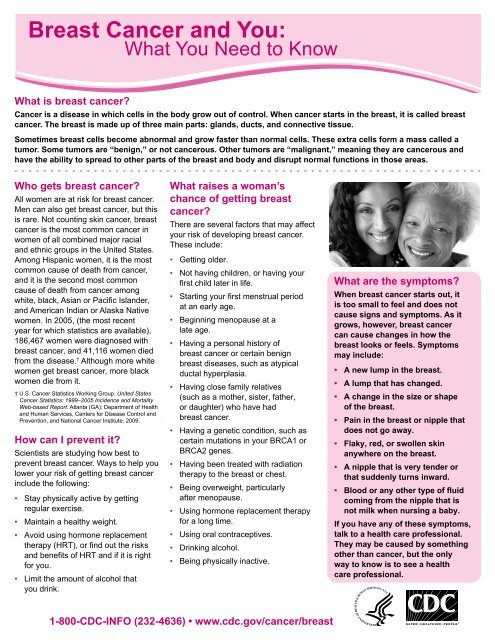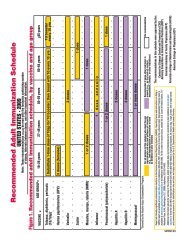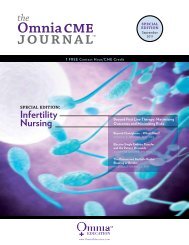Breast Cancer Fact Sheet - Wellness Proposals
Breast Cancer Fact Sheet - Wellness Proposals
Breast Cancer Fact Sheet - Wellness Proposals
You also want an ePaper? Increase the reach of your titles
YUMPU automatically turns print PDFs into web optimized ePapers that Google loves.
<strong>Breast</strong> <strong>Cancer</strong> and You:<br />
What You Need to Know<br />
What is breast cancer<br />
<strong>Cancer</strong> is a disease in which cells in the body grow out of control. When cancer starts in the breast, it is called breast<br />
cancer. The breast is made up of three main parts: glands, ducts, and connective tissue.<br />
Sometimes breast cells become abnormal and grow faster than normal cells. These extra cells form a mass called a<br />
tumor. Some tumors are “benign,” or not cancerous. Other tumors are “malignant,” meaning they are cancerous and<br />
have the ability to spread to other parts of the breast and body and disrupt normal functions in those areas.<br />
Who gets breast cancer<br />
All women are at risk for breast cancer.<br />
Men can also get breast cancer, but this<br />
is rare. Not counting skin cancer, breast<br />
cancer is the most common cancer in<br />
women of all combined major racial<br />
and ethnic groups in the United States.<br />
Among Hispanic women, it is the most<br />
common cause of death from cancer,<br />
and it is the second most common<br />
cause of death from cancer among<br />
white, black, Asian or Pacific Islander,<br />
and American Indian or Alaska Native<br />
women. In 2005, (the most recent<br />
year for which statistics are available),<br />
186,467 women were diagnosed with<br />
breast cancer, and 41,116 women died<br />
from the disease. † Although more white<br />
women get breast cancer, more black<br />
women die from it.<br />
† U.S. <strong>Cancer</strong> Statistics Working Group. United States<br />
<strong>Cancer</strong> Statistics: 1999–2005 Incidence and Mortality<br />
Web-based Report. Atlanta (GA): Department of Health<br />
and Human Services, Centers for Disease Control and<br />
Prevention, and National <strong>Cancer</strong> Institute; 2009.<br />
How can I prevent it<br />
Scientists are studying how best to<br />
prevent breast cancer. Ways to help you<br />
lower your risk of getting breast cancer<br />
include the following:<br />
• Stay physically active by getting<br />
regular exercise.<br />
• Maintain a healthy weight.<br />
• Avoid using hormone replacement<br />
therapy (HRT), or find out the risks<br />
and benefits of HRT and if it is right<br />
for you.<br />
• Limit the amount of alcohol that<br />
you drink.<br />
What raises a woman’s<br />
chance of getting breast<br />
cancer<br />
There are several factors that may affect<br />
your risk of developing breast cancer.<br />
These include:<br />
• Getting older.<br />
• Not having children, or having your<br />
first child later in life.<br />
• Starting your first menstrual period<br />
at an early age.<br />
• Beginning menopause at a<br />
late age.<br />
• Having a personal history of<br />
breast cancer or certain benign<br />
breast diseases, such as atypical<br />
ductal hyperplasia.<br />
• Having close family relatives<br />
(such as a mother, sister, father,<br />
or daughter) who have had<br />
breast cancer.<br />
• Having a genetic condition, such as<br />
certain mutations in your BRCA1 or<br />
BRCA2 genes.<br />
• Having been treated with radiation<br />
therapy to the breast or chest.<br />
• Being overweight, particularly<br />
after menopause.<br />
• Using hormone replacement therapy<br />
for a long time.<br />
• Using oral contraceptives.<br />
• Drinking alcohol.<br />
• Being physically inactive.<br />
What are the symptoms<br />
When breast cancer starts out, it<br />
is too small to feel and does not<br />
cause signs and symptoms. As it<br />
grows, however, breast cancer<br />
can cause changes in how the<br />
breast looks or feels. Symptoms<br />
may include:<br />
• A new lump in the breast.<br />
• A lump that has changed.<br />
• A change in the size or shape<br />
of the breast.<br />
• Pain in the breast or nipple that<br />
does not go away.<br />
• Flaky, red, or swollen skin<br />
anywhere on the breast.<br />
• A nipple that is very tender or<br />
that suddenly turns inward.<br />
• Blood or any other type of fluid<br />
coming from the nipple that is<br />
not milk when nursing a baby.<br />
If you have any of these symptoms,<br />
talk to a health care professional.<br />
They may be caused by something<br />
other than cancer, but the only<br />
way to know is to see a health<br />
care professional.<br />
1-800-CDC-INFO (232-4636) • www.cdc.gov/cancer/breast
mammogram<br />
What you should know about getting a. . .<br />
What should I expect during a mammogram<br />
The mammography machine is a special X-ray machine. One<br />
of your breasts will be placed on a plate. Another plate will<br />
press down on your breast from above. The plates will hold<br />
your breast still while the X-ray is being taken. These steps are<br />
repeated to get a view of the other breast. The plates are then<br />
turned to get side views of each breast.<br />
Is there a test that can find breast<br />
cancer early<br />
Mammograms are the best tests for finding breast cancer<br />
early. Mammograms are a series of X-ray pictures of the breast<br />
that allow doctors to look for early signs of breast cancer,<br />
sometimes up to three years before it can be felt. When breast<br />
cancer is found early, treatment is most effective, and many<br />
women go on to live long and healthy lives.<br />
When should I get a mammogram<br />
Most women should have their first mammogram at age 40<br />
and then have another mammogram every one or two years.<br />
If you have any symptoms or changes in your breast, or if<br />
breast cancer runs in your family, talk to your health care<br />
professional. He or she may recommend that you have<br />
mammograms earlier or more often than other women.<br />
What happens if my mammogram<br />
is abnormal<br />
If your mammogram is abnormal or more tests are required,<br />
do not panic. Many women need additional tests, and most are<br />
not diagnosed with cancer. An abnormal mammogram does not<br />
always mean you have cancer. It does mean that you will need<br />
to have some additional X-rays or other tests before your doctor<br />
can be sure. Other tests may include an ultrasound (picture<br />
taken of the breast using sound waves) or a biopsy (removing<br />
tissue samples to be looked at closely under a microscope).<br />
You may be referred to a breast specialist or a surgeon,<br />
because these doctors are experts in diagnosing<br />
breast problems.<br />
Although getting a mammogram only takes a few minutes,<br />
you will feel some pressure while the plates are pressing on<br />
your breast. Most women find it uncomfortable, and a few find<br />
it painful. What you feel depends on the size of your breasts,<br />
how much your breasts need to be pressed to get a good view,<br />
the skill of the technologist, and where you are in your monthly<br />
menstrual cycle, if you are still having periods.<br />
After getting your mammogram, the technologist will check to<br />
make sure your X-rays are of good quality. They cannot read<br />
the X-ray or tell you the results. A radiologist will read your<br />
mammogram. You may receive results immediately, or they<br />
will be sent to you and your doctor within a few weeks. If your<br />
mammogram is abnormal, you will likely hear from the facility<br />
earlier. If you do not receive your results within 30 days,<br />
you should contact your health care provider or the<br />
mammography facility.<br />
Where can I find more information about<br />
breast cancer<br />
Centers for Disease Control and Prevention:<br />
1-800-CDC-INFO or www.cdc.gov/cancer<br />
National <strong>Cancer</strong> Institute:<br />
1-800-4-CANCER or www.cancer.gov<br />
American <strong>Cancer</strong> Society:<br />
1-800-ACS-2345 or www.cancer.org<br />
People Living with <strong>Cancer</strong>/American Society<br />
of Clinical Oncology:<br />
1-888-651-3038 or www.plwc.org<br />
Where can I find a free or low-cost mammogram<br />
If you have a low income, or do not have insurance, and are between the ages of 40 and 64, you may be able to get<br />
a free or low-cost mammogram through the National <strong>Breast</strong> and Cervical <strong>Cancer</strong> Early Detection Program in your<br />
community. To learn more, call 1-800-CDC-INFO or visit www.cdc.gov/cancer/nbccedp online.<br />
99-9520





